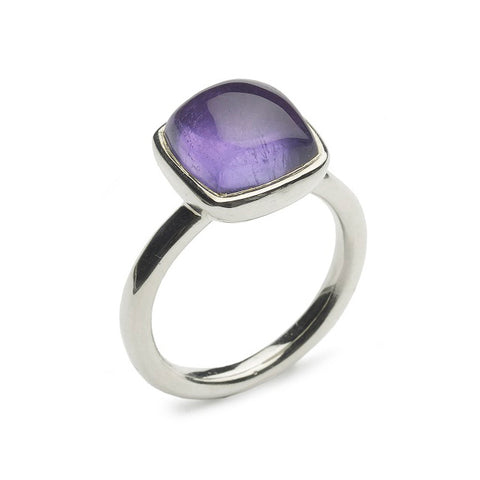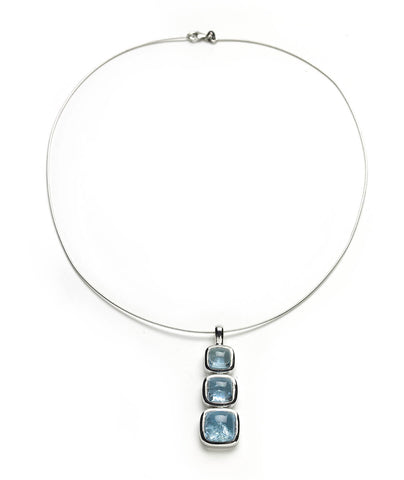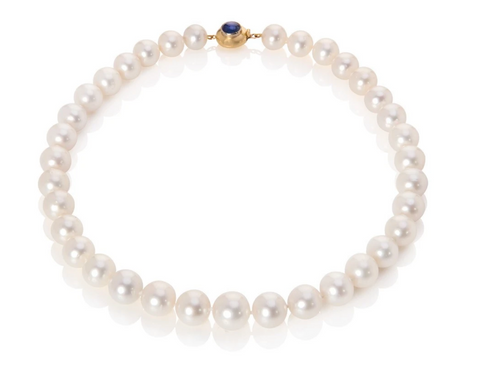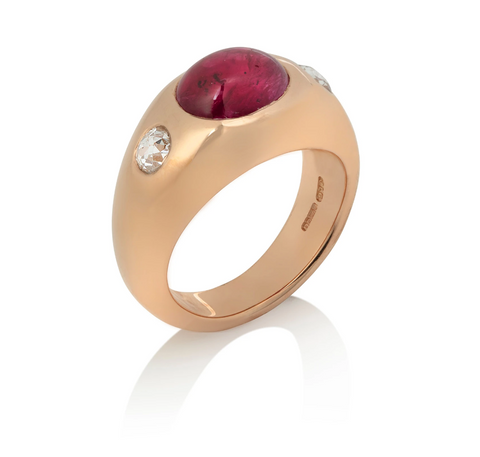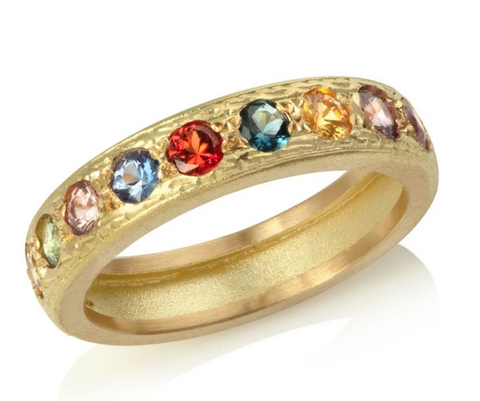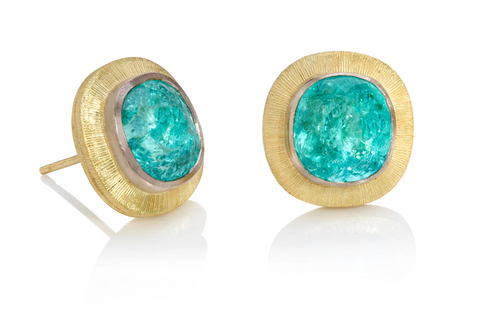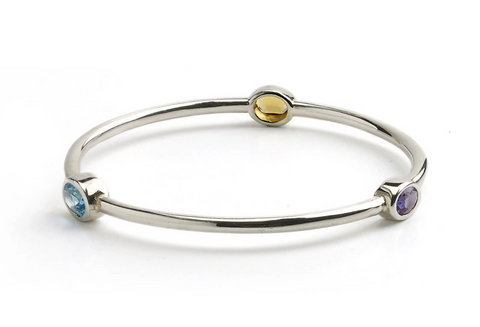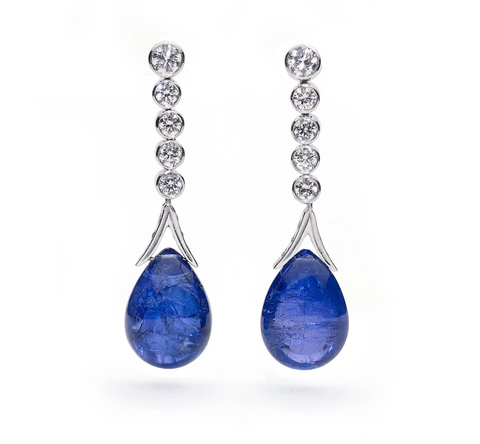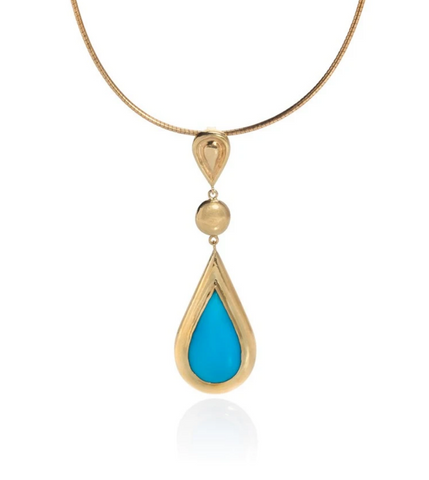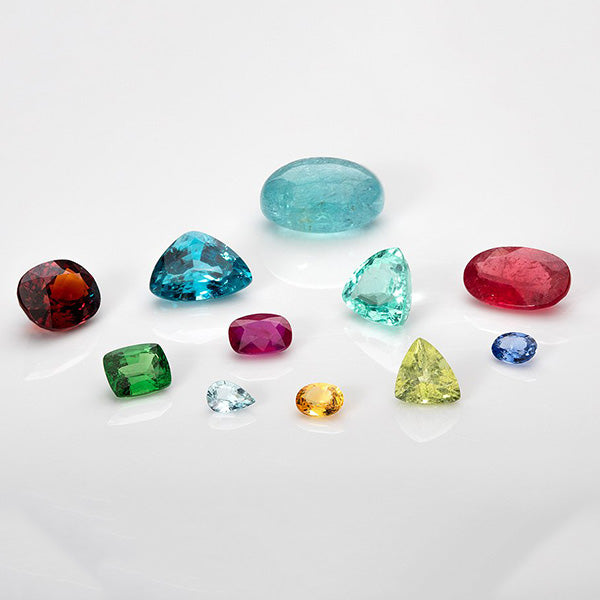
JANUARY – GARNET
Garnet is generally thought of as a dark red stone, but can come in many other colours and shades. The earliest garnet jewellery dates back to the Bronze Age. It was particularly favoured by the ancient Greeks, and it is thought that they were the first to use it for signet rings. Garnet is mainly symbolic of truth and constancy. Julia uses a range of garnets in her work including Hessonite, Mandarin garnet, Malayan garnet and Rhodonite garnet.
FEBRUARY – AMETHYST
Found in Brazil, Uruguay, and Madagascar. Amethyst is the most highly valued stone in the quartz group. It is said to have supernatural powers. The word amethyst is derived from the Greek word 'amethystos' which means 'sober', as it was once believed to prevent drunkenness. Nowadays it is believed that it brings luck, ensures constancy, protects against magic and homesickness. Julia has a wonderful collection of affordable Amethyst pieces.
MARCH - AQUAMARINE
Aquamarine is from the beryl family. It is characterised by pale blue colour, which also gives it its name. Aquamarines are mined all over the world including Argentina, Australia, Brazil and Russia. Aquamarine is a stone is often associated with the qualities of happiness and understanding – and has been traditionally used for engagement rings for this reason. Julia uses aquamarines in many of her pieces, using both the greener stones as well as the more traditional icy blue.
APRIL - DIAMOND
Diamonds have been used for adornment since very early times, and they were once thought to be crystallised lightning found within the earth. Diamonds are a pure carbon lattice, they come in a range of colours from yellow to red, pink, green, and blue. However, the colourless variety is the most highly prized. The optical properties of this stone are exceptional, their sparkle and rarity make them the king of gems. Romantic in history and symbolic of love, they have been used in engagement rings for many years. Julia tends to juxtapose her diamonds with coloured gems, and her signature setting in rich yellow gold has a stunning effect. Julia often also uses the unusual rose cuts and coloured diamonds.
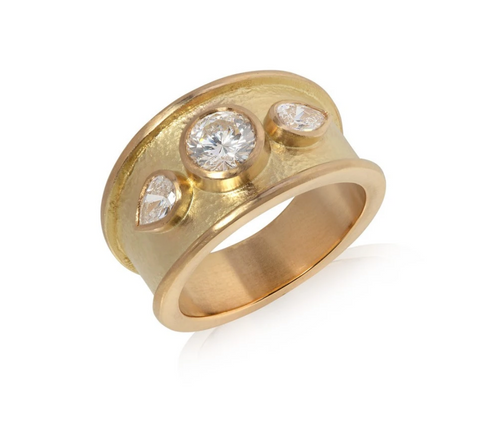
MAY – EMERALD
Emerald is also from the beryl family, and is the most precious of the group. Only the finest emeralds are transparent. They have the most beautiful, intense, radiant green that can possibly be imagined. Emeralds have been held in high esteem since ancient times and are thought to enhance wellbeing and promise good luck. While its good hardness protects the emerald to a large extent from scratches, the brittleness of its crystal structure can make cutting, setting and cleaning difficult. However, cutters have developed a unique cut just for this stone; the emerald cut - rectangular with bevelled corners, which brings out the beauty of the stone at the same time as protecting it from mechanical strain. Julia uses emeralds of the most exceptional colour, such as in this Colombian emerald cabochon ring below.
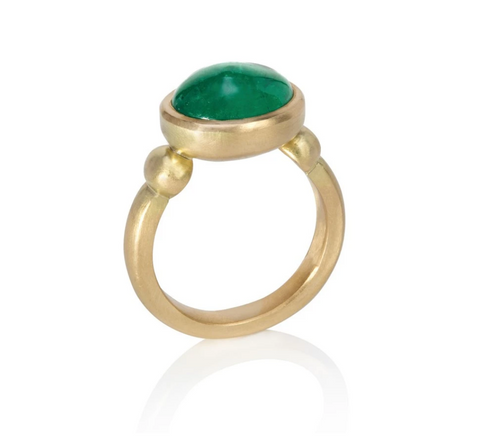
JUNE – PEARL
A pearl is a hard object produced within the soft tissue of a living shelled mollusc. The ideal pearl is perfectly round, but many other shapes (i.e. Baroque pearls) occur and have their own charm. The finest quality natural pearls have been highly valued as gemstones and objects of beauty for centuries. The most valuable pearls are ‘natural pearls’, which occur in the wild but are extremely rare. Cultured, or farmed, pearls make up the majority of those currently sold. Pearls appear throughout Julia’s collections, they are always classic and beautiful. Below is a string of South Sea pearls, these pearls are much larger than the average pearl, and are prized not only for their size but their smoothness and roundness.
JULY – RUBY
Ruby is thus named because of its red colour, rubeus in Latin. It is the hardest stone after diamond. Rubies are mined around the world throughout Burma (Myanmar), Thailand, India, Afghanistan, Mozambique, Sri Lanka and Tanzania. The most important area for rubies is northern Burma, the Mogok Valley. The brightest and most valuable shade of ruby is known as pigeon’s blood. Both cabochon and facetted rubies appear throughout Julia’s collections, their rich warmth often contrasted against the coolness of white diamonds.
AUGUST – PERIDOT
Peridot is the name given to gemstone quality material of the mineral olivine. The name peridot is from the Greek work 'peridona' which means 'to give richness'. Most of the gem quality peridot in the world comes from Arizona, however it is also found in Pakistan, Myanmar, and China. Peridots have been popular for many millenia, particularly among the ancient Egyptians and the Romans. Peridots are often contrasted with blues in Julia’s work, for example set with aquamarines, or enamel, as below.
SEPTEMBER – SAPPHIRE
Sapphires take their name from the Latin ‘sapphirus’ or blue stone. It is a gemstone variety of the mineral Corundum. Sapphires naturally occur in a wide variety of colours, such as blue, yellow, purple, orange and green colours, which are called ‘fancy sapphires’. It is very desirable due to its excellent colour, hardness, durability and lustre. Important sources include Sri Lanka, Burma (Myanmar), Thailand, Cambodia, Madagascar, Tanzania, Australia and The US (Montana). The Kashmir region of India / Pakistan was famous for its ‘Kashmir blue’ sapphire, but little material comes from there today. Sri Lankan (Ceylon) sapphires are well-known for their excellent colour. Julia uses sapphires of every colour and shade often using many different colours of sapphire in one piece.
OCTOBER – TOURMALINES (including PARAIBA TOURMALINES)
Tourmaline comes in more colours than any other stone. The most productive deposits are in Brazil. The most desired colours are pink, red and green.
None of these tourmalines have the distinctive, vivid glow of the ‘cuprian elbaite’ also known as Paraiba Tourmaline. Since their recent discovery in the 1980s these neon bright stones have become one of the most sought after and most valuable gemstones in the world. To put their rarity into perspective, there is only one Paraiba tourmaline mined for every 10,000 diamonds. High quality Brazilian Paraiba tourmalines are so valuable that is not unusual for them to achieve five figures per carat. At the time of writing the Brazilian mine is currently closed, and there is little rough material coming from Mozambique. Making them even more valuable.
Julia has established a reputation as the queen of Paraiba Tourmalines. She has formed good sources for these stones both in Brazil and Mozambique. She usually sets these stones in 18ct yellow gold, which is her interpretation of nature’s sand and sea.
NOVEMBER – CITRINE / TOPAZ
Citrine is from the quartz family. Natural citrine is quite rare, and is pale yellow in colour. The most common citrine is actually heat-treated amethyst, but it can also be made from smoky quartz. Gem quality citrine is found in Russia, India, France, Brazil, Spain and in North Carolina. Citrine was beloved by the ancient Egyptians who used it in talismans. Today, citrine is known as the ‘merchant’s stone’ and is associated with success and wealth. As an unusual stone Julia often uses both as cabochons and facetted, often juxtaposing it with other brightly coloured gemstones.
DECEMBER – TANZANITE / TURQUOISE
December has two birthstones associated with it, turquoise and tanzanite.
Tanzanite is a relatively recently discovered stone. It is only mined in Tanzania, near Mt. Kilimanjaro, which is how it gets its name. Tanzanite is usually heat-treated to reduce impurities and intensify its characteristic purply blue colour. This more intense colour is permanent and is considered an acceptable treatment. Tanzanite has become a very popular stone.
Turquoise is unlike most gemstones in that it is opaque rather than translucent. Its characteristic colour can varies from sky blue to green grey. The bluer stones tend to be more valuable and contain more copper. Turquoise is sometimes criss-crossed by a ‘matrix’, remnants of the rock in which it formed. Turquoise is thought to be a good luck stone bringing happiness and good fortune.

